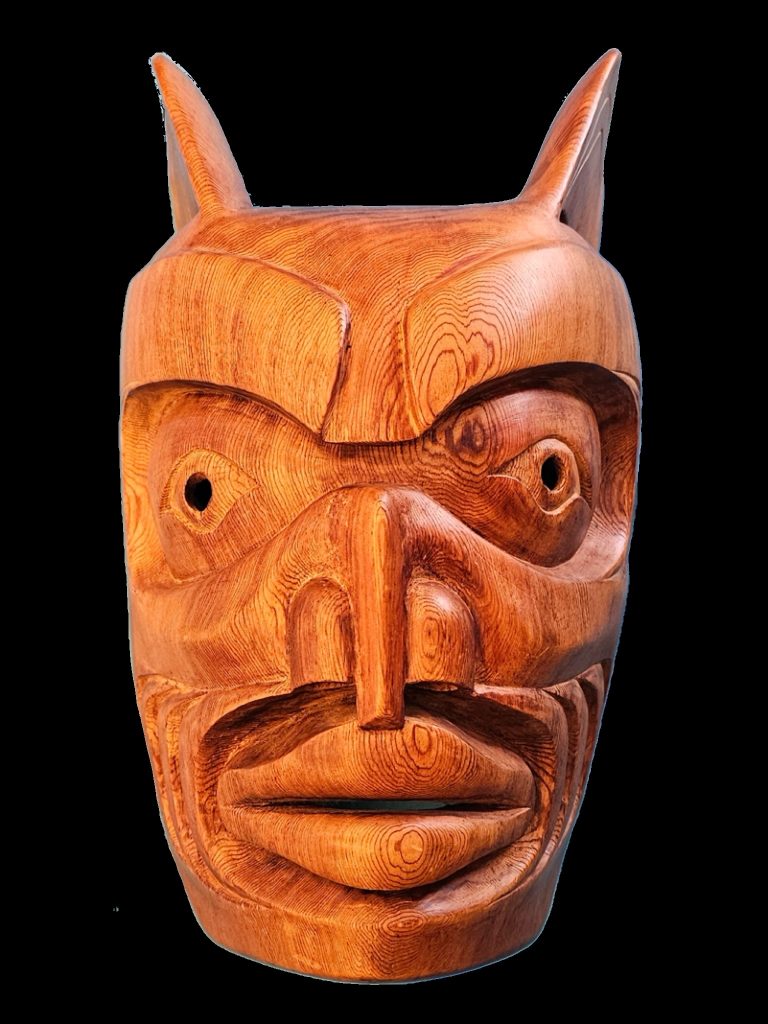By Hi’iakalehuakaulei Hashimoto, Curatorial Intern for Indigenous Art (2023-), McGill Visual Arts Collection
Many Indigenous peoples of the Northwest coast, including Kwakwaka’wakw, tell stories of the Bakwas, or Bookwus (wild man of the woods), a “supernatural” being who dwells in the wilderness. In stories passed down through generations, Bookwus is the keeper of lost spirits and is always looking to add to his collection of souls. He attempts to lure anyone lost in the woods with cockle shells filled with “ghost food”. The soul of one who eats this food shall be brought to the ghost world, made to wander endlessly and hunger eternally.

This mask by Haisla artist, Henry Robertson, is representative of depictions of Bookwus, who is typically represented with a stark visage. Here, the wood grain accentuates a thick furrowed brow and a pair of sunken eye sockets. From these hollow recesses two bulging, round eyes emerge with a piercing inhuman gaze. A beak-like nose points down towards a set of large, taut lips, as if grimacing at his prey. The gaunt face is made more skeletal with extra ridges carved around the mouth, accentuating his supernatural status as a keeper of souls.
When researching artworks, it is easy to fall into a sea of endless pondering. I have learned that it is more productive to begin with one question and see where my research takes me. A seemingly simple question can often result in unexpected revelations and new perspectives. For instance, I might start by asking: “What is it made of?”
This mask and many others from the Pacific Northwest region of Canada are made of Western Red Cedar. Its roots, bark, wood, and foliage are utilized in every aspect of their lives.[1] Clothing, construction, canoes, and even tools were made of Western Red Cedar. While this explanation seems to be rather straightforward, a fascinating detail about this species of cedarwood piqued a deeper curiosity: Cedar is not in fact native to the Americas.
Thuja Plicata, or the Western Red Cedar is most often associated with two things, the fact that it is the largest “cedar,” and that it is native to North America. Given this characterization, it is rather surprising to learn that according to taxonomic analysis, Thuja Plicata is not classified as a “true” cedar, and instead belongs to the Cupressaceae (Cypress) family. Furthermore, its closest relative is neither the yellow nor white “cedar” trees found in North America, but rather T. Koraiensis, an endangered species native to Korea.[2] In fact, every “cedar” tree in North America that existed prior to European colonization is in reality not a cedar at all. Simply put, there are no “cedar” trees in North America, at least ones that predate colonial importation.
The trees are primarily found on the coast of Oregon, Washington and British Columbia. A tree doesn’t reach “maturity” until its third century of growth.[3] Felling one of these giants is a difficult, and time-consuming endeavor. This begs another question, why go through all this effort?
The lumber itself is beautiful. The straight grain wood takes paint very readily and splits well. The Western Red Cedar is regarded as a woodworker’s best friend, with modern applications ranging from guitar making to beekeeping. The lumber is highly sought after for construction projects due to its natural decay-resistant properties as well as its aesthetic qualities. Thuja Plicata produces Thujaplicins, a chemical that makes it highly resistant to fungal growth, meaning that untreated, the lumber can remain rot-free for up to a century after the tree was first felled.[4] This information in turn reveals why many First Nations might have chosen to utilize the tree so frequently. Its natural anti-rotting properties meant that it was ideal for constructing everyday items such as x̱a̱lḵ̕wa (bowls) and da̱na̱m (rope) as well as larger projects such as gukw (house) and xwak̕wa̱na (canoe).
Recently, however there has been growing concern about the over-consumption of Western Red Cedar and its effects on Indigenous practices. The aforementioned Thujaplicins only occur in mature specimens, meaning that the farm produced young growth trees that are harvested early have not had time to develop anti-fungal properties.[5] To combat this over-consumption, the Canadian government has placed restrictions on attempts to harvest old growth forests. These restrictions have made Indigenous artistic practices much harder in modern times, as the process of acquiring material is now thoroughly regulated.
Understanding the difficulties and limitations of procuring this specific type of wood adds another rung of appreciation to Bookwus. Henry Robertson is a highly trained artist who has learned how to transform Western Red Cedar into a culturally significant artwork what is now cared for by the McGill Visual Arts Collection. This raw material has a built-in anti-aging property, but it is now our responsibility to care for it and ensure that it can be studied and enjoyed for generations to come.
[1] Hilary Stewart, Cedar: Tree of Life to the Northwest Coast Indians (Seattle, Washington: University of Washington Press, 1995), 22.
[2] Dan Peng and Xiao-Quan Wang, “Reticulate Evolution in Thuja Inferred from Multiple Gene Sequences: Implications for the Study of Biogeographical Disjunction between Eastern Asia and North America,” Molecular Phylogenetics and Evolution 47, no. 3 (June 3, 2008): 1190–1202, https://doi.org/https://doi.org/10.1016/j.ympev.2008.02.001.
[3] “British Columbia – Western Redcedar,” Tree Canada, October 30, 2017, https://treecanada.ca/resources/canadas-arboreal-emblems/western-redcedar/.
[4] Russel J. Chedgy, Young Woon Lim, and Colette Breuil, “Effects of Leaching on Fungal Growth and Decay of Western Redcedar,” Canadian Journal of Microbiology 55 (May 15, 2009): 578–86, https://doi.org/https://doi.org/10.1139/W08-161.
[5] Ibid.











